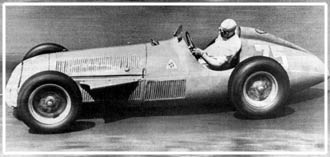 1951 It perhaps might have been assumed that the mighty Nurburgring Nordschliefe would have been an automatic inclusion in the original world championship in 1950, but it was not. In the years after the war the German Grand Prix was not run, with images of the Nazi backed domination of the sport by Mercedes and Auto Union perhaps a little too fresh. The grandeur of the Nurburgring demanded attention though. Here Juan Manuel Fangio races the Alfa Romeo 159 on his way to second place.
1951 It perhaps might have been assumed that the mighty Nurburgring Nordschliefe would have been an automatic inclusion in the original world championship in 1950, but it was not. In the years after the war the German Grand Prix was not run, with images of the Nazi backed domination of the sport by Mercedes and Auto Union perhaps a little too fresh. The grandeur of the Nurburgring demanded attention though. Here Juan Manuel Fangio races the Alfa Romeo 159 on his way to second place.
 1953 At the height of his powers Alberto Ascari was considered to be almost an equal to Juan Manuel Fangio, but circumstance combined to keep fair head to head battles to only a handful of races after Fangio missed much of 52 and 53 with a broken neck and Ascari suffering a long period of testing the Lancia before it raced then Ascari's premature death at Monza in 1955. Here Ascari sweeps the Ferrari 500 along the wide expanse of the Nurbrugring grid area on his way to a lonely 8th in Luigi Villoresi's car.
1953 At the height of his powers Alberto Ascari was considered to be almost an equal to Juan Manuel Fangio, but circumstance combined to keep fair head to head battles to only a handful of races after Fangio missed much of 52 and 53 with a broken neck and Ascari suffering a long period of testing the Lancia before it raced then Ascari's premature death at Monza in 1955. Here Ascari sweeps the Ferrari 500 along the wide expanse of the Nurbrugring grid area on his way to a lonely 8th in Luigi Villoresi's car.
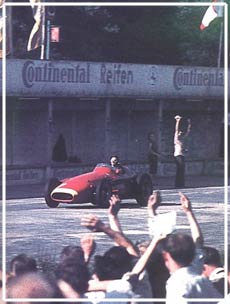 1957 Past the pits comes the red Maserati 250F of the four, soon the be five times world champion, Juan Manuel Fangio as the crowd acknoledge one of the greatest drives in the history of Formula One. Fangio gambled on a light fuel load and superior qualifying speed to beat the Ferrari's of Mike Hawthorn and Peter Collins. The pit stop was a shambles and the Maserati team waved Fangio back into the race after almost a minute. Fangio hunted down the Ferrari relentless taking ten seconds out of the lead on one lap. Collins faded with broken goggles as Fangio and Hawthorn diced over the final laps. Fangio held the advantage down the long straight and the two embraced after it was over.
1957 Past the pits comes the red Maserati 250F of the four, soon the be five times world champion, Juan Manuel Fangio as the crowd acknoledge one of the greatest drives in the history of Formula One. Fangio gambled on a light fuel load and superior qualifying speed to beat the Ferrari's of Mike Hawthorn and Peter Collins. The pit stop was a shambles and the Maserati team waved Fangio back into the race after almost a minute. Fangio hunted down the Ferrari relentless taking ten seconds out of the lead on one lap. Collins faded with broken goggles as Fangio and Hawthorn diced over the final laps. Fangio held the advantage down the long straight and the two embraced after it was over.
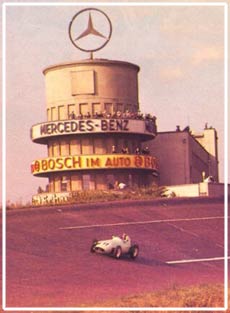
1959 Hans Herrmann fires the British Racing Partnership run BRM P25 down off the huge banking of northern curve of the AVUS circuit near Berlin. Originally two long sections of autobahn linked two corners, one of them a huge banked loop, the other flat concrete. The circuit, used only this once for Formula One was still operating well into the 80's but was shortened twice. The first time was after the construction of the Berlin Wall which the circuit straddled. The surviving section in West Berlin was shortened again in 1967 with the demolition of the banking.
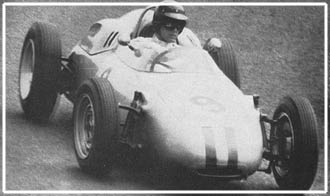
1961 A rarity for the German fans who camped out in the Eiffel woods to watch the cars fly through, and over the Nordschliefe, a competitive German car. The Porsche 718 was never quite at home here in 1961 though, with Dan Gurney racing this one to seventh place. Porsche would return here years later with sports cars that ruled and frightene the Nurburgring, even to the point of factory Porsche drivers refusing the drive the frighteningly quick but evil handling early Porsche 917's at the Nordschliefe.
 1964
1964
In the 60's hazards such as poles close to the edge of circuits were not uncommon. Here Ronnie Bucknum in the debut appearance of Honda in Formula steers the Honda RA271 past one such hazard on the giant German circuit. That first Honda as you might expect was off the pace and it's driver, more used to the circuits of the US than of Europe spun off.
 1966
1966
Airborne! Jochen Rindt takes to the air in the factory Cooper T81 Maserati. The Coopers of the three litre era were gradually being left behind, but at the Nordschliefe that first year they were quite effective with the Austrian following his British team leader, John Surtees, home to third place. Up front though was the nimble little Brabham BT19 Repco of Jack Brabham.
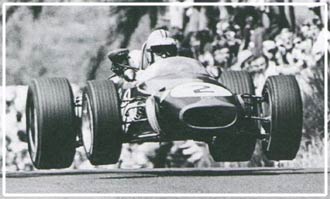 1967 Airborne 2! Eventual 1967 world champion Denny Hulme gets air under all four wheels of his Brabham BT24 over one of the Nordschliefe's many launching ramps. The nimble Brabham's were well suited to the Nurburgring where handling was most important. Hulme and Brabham would score a 1-2 this day for the Australian team who won two world championships despite the difficulties of developing an engine program over such long distances.
1967 Airborne 2! Eventual 1967 world champion Denny Hulme gets air under all four wheels of his Brabham BT24 over one of the Nordschliefe's many launching ramps. The nimble Brabham's were well suited to the Nurburgring where handling was most important. Hulme and Brabham would score a 1-2 this day for the Australian team who won two world championships despite the difficulties of developing an engine program over such long distances.
 1968 Jackie Stewart used to stop and look back along the driveway to his house before each trip the the Eiffel Mountains in Germany, such was the respect, even fear he held of the circuit. Nurburgring in the wet is a recurring nightmare for all who race there, the trees prevent spray from disappating. As if innumerable treacherous corners aren't enough, to tackle them with much reduced traction and visibility is a true measure of skill and bravery. Despite his personal views Stewart won this day in the Matra MS10 Cosworth.
1968 Jackie Stewart used to stop and look back along the driveway to his house before each trip the the Eiffel Mountains in Germany, such was the respect, even fear he held of the circuit. Nurburgring in the wet is a recurring nightmare for all who race there, the trees prevent spray from disappating. As if innumerable treacherous corners aren't enough, to tackle them with much reduced traction and visibility is a true measure of skill and bravery. Despite his personal views Stewart won this day in the Matra MS10 Cosworth.
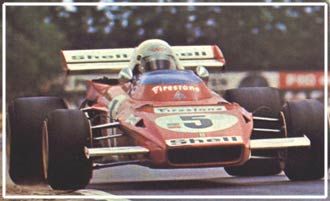 1971 The great American Mario Andretti did not become a feature of Formula One until the late 70s, but he made his presense felt as early as 1968 getting a pole position for Lotus at Watkins Glen. He made sporadic forays into Formula One throughout the 70s including the Nordschliefe in 1971 aboard the Scuderia's 312B2. Andretti qualified eleventh and finished fourth behind team mate Jacky Ickx and the 1-2 result for Tyrrell's Jackie Stewart and Francois Cevert.
1971 The great American Mario Andretti did not become a feature of Formula One until the late 70s, but he made his presense felt as early as 1968 getting a pole position for Lotus at Watkins Glen. He made sporadic forays into Formula One throughout the 70s including the Nordschliefe in 1971 aboard the Scuderia's 312B2. Andretti qualified eleventh and finished fourth behind team mate Jacky Ickx and the 1-2 result for Tyrrell's Jackie Stewart and Francois Cevert.
 1972 Germany has had few names to cheer until the advent of Michael Schumacher, In the 60s there was Wolfgang 'Taffy' von Trips who was cruelly robbed from the sport at his peak. In the 70s Jochen Mass and Rolf Stommelen raced several season but never really got there while Hans-Joachim Stuck showed the promise but perhaps not the application. Here Stommelen steers the unusual lines of the Eifelland March 21 Cosworth through concrete banking of the Karussel. Note the rear view mirror mounted above the driver head, like on sports cars of the era only front mounted through the lack of a sports car roof and the air intake at the front.
1972 Germany has had few names to cheer until the advent of Michael Schumacher, In the 60s there was Wolfgang 'Taffy' von Trips who was cruelly robbed from the sport at his peak. In the 70s Jochen Mass and Rolf Stommelen raced several season but never really got there while Hans-Joachim Stuck showed the promise but perhaps not the application. Here Stommelen steers the unusual lines of the Eifelland March 21 Cosworth through concrete banking of the Karussel. Note the rear view mirror mounted above the driver head, like on sports cars of the era only front mounted through the lack of a sports car roof and the air intake at the front.
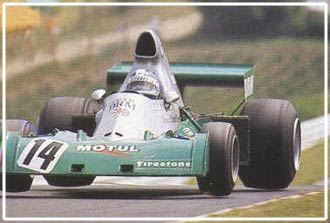 1974
1974
As aerodynamics became increasingly part of the science of Formula One the cars hugged the corners tighter and lower, but still at the Nordschliefe they could still defy gravity over the launching ramps liek the Flugenplatz. Here Jean-Pierre Beltoise gets his BRM P201 airborne.
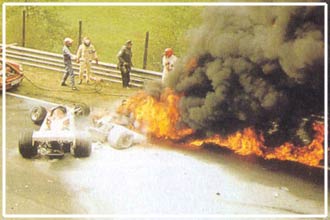 1976 The Ferrari 312T2 continues to burn beyond any recognition, and beyond any thought of what would follow. Niki Lauda crashed heavily on the opening lap on the fast stretch towards Bergwerk on the run towards the Karussel. Lauda was trapped in the car when it burst into flame then was clipped by Brett Lunger Surtees TS19 Cosworth seen to the left. Lunger, Guy Edwards, Harald Ertl, and a marshall all helped while Arturo Merzario plucked Lauda from the car, burning himself in the process. Lauda was nadly burned and had inhaled poisonous fumes, his life dangled from a thread for weeks, and last rites were administerred. By the end of the season Lauda was back in the car racing. While Lauda survived, the Nurburgring did not and the great circuit was abandoned to Sports Cars and Touring Cars.
1976 The Ferrari 312T2 continues to burn beyond any recognition, and beyond any thought of what would follow. Niki Lauda crashed heavily on the opening lap on the fast stretch towards Bergwerk on the run towards the Karussel. Lauda was trapped in the car when it burst into flame then was clipped by Brett Lunger Surtees TS19 Cosworth seen to the left. Lunger, Guy Edwards, Harald Ertl, and a marshall all helped while Arturo Merzario plucked Lauda from the car, burning himself in the process. Lauda was nadly burned and had inhaled poisonous fumes, his life dangled from a thread for weeks, and last rites were administerred. By the end of the season Lauda was back in the car racing. While Lauda survived, the Nurburgring did not and the great circuit was abandoned to Sports Cars and Touring Cars.
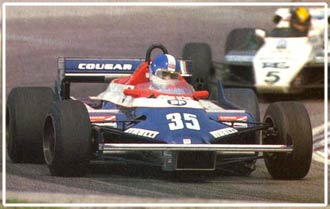 1982 Derek Warwick in the Toleman TG181C Hart leads the Williams FW08 Cosworth of Derek Daly at the Hockenheimring. 1982 was another dark day in Germany with the terrible qualifying crash to Ferrari's Didier Pironi. It was though that Pironi might never recover. Five years later after innumerable operations Pironi reportedly tested with Ligier and was negotiating a contract with Larrousse when he was killed in an offshore powerboat race. Warwick finished tenth in the Toleman, while Daly retired just past half distance with an expired engine.
1982 Derek Warwick in the Toleman TG181C Hart leads the Williams FW08 Cosworth of Derek Daly at the Hockenheimring. 1982 was another dark day in Germany with the terrible qualifying crash to Ferrari's Didier Pironi. It was though that Pironi might never recover. Five years later after innumerable operations Pironi reportedly tested with Ligier and was negotiating a contract with Larrousse when he was killed in an offshore powerboat race. Warwick finished tenth in the Toleman, while Daly retired just past half distance with an expired engine.
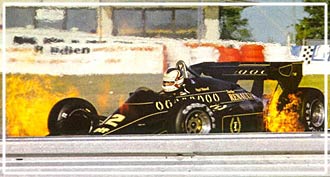 1984 Just one of the many problems the befell Nigel Mansell's Lotus 95T Renault during practice at the Hockenheimring. Mansell would qualify 16th after a littany gearbox, electric, fuel pump, turbo and finally rain problems. But an excellent drive in the race so him through to fourth place behind the dominant McLarens of Alain Prost and Niki Lauda, and the Renault RE50 of Derek Warwick.
1984 Just one of the many problems the befell Nigel Mansell's Lotus 95T Renault during practice at the Hockenheimring. Mansell would qualify 16th after a littany gearbox, electric, fuel pump, turbo and finally rain problems. But an excellent drive in the race so him through to fourth place behind the dominant McLarens of Alain Prost and Niki Lauda, and the Renault RE50 of Derek Warwick.
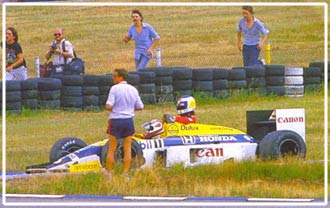 1986 The victorius Nelson Piquet (Williams FW11 Honda) returns to the pits with the man he battled with all day Keke Rosberg on his sidepod. Rosberg in an emotional announcement stated he would be retiring at the end of the year, he then took pole and joked, "I'll drive like hell, lead the race and run out of fuel on the last lap." But that was what he did, a faulty fuel guage meant Rosberg's McLaren never completed the last lap, dropping from second to fifth. Team mate Alain Prost also ran dry dropping to sixth, alloying Ayrton Senna, Nigel Mansell and Rene Arnoux through to claim second to fourth.
1986 The victorius Nelson Piquet (Williams FW11 Honda) returns to the pits with the man he battled with all day Keke Rosberg on his sidepod. Rosberg in an emotional announcement stated he would be retiring at the end of the year, he then took pole and joked, "I'll drive like hell, lead the race and run out of fuel on the last lap." But that was what he did, a faulty fuel guage meant Rosberg's McLaren never completed the last lap, dropping from second to fifth. Team mate Alain Prost also ran dry dropping to sixth, alloying Ayrton Senna, Nigel Mansell and Rene Arnoux through to claim second to fourth.
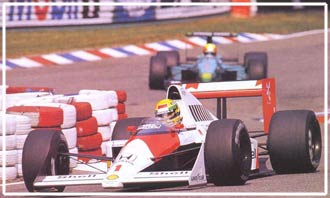 1989 Ayrton Senna and McLaren MP4/5 Honda on their way to victory through one of the disruptive Hockenheim chicanes. Throughot the 1989 season a true head to head battle between Senna and Alain Prost had not happenned, with something preventing one or the other from being fully competitive. Finally, depsite messy pitstops we got that battle. A battle Prost had been leading until gearbox problems gave Senna the lead. Behind Senna is the March CG891 of Mauricio Gugelmin who failed to finish because of gearbox difficulties.
1989 Ayrton Senna and McLaren MP4/5 Honda on their way to victory through one of the disruptive Hockenheim chicanes. Throughot the 1989 season a true head to head battle between Senna and Alain Prost had not happenned, with something preventing one or the other from being fully competitive. Finally, depsite messy pitstops we got that battle. A battle Prost had been leading until gearbox problems gave Senna the lead. Behind Senna is the March CG891 of Mauricio Gugelmin who failed to finish because of gearbox difficulties.
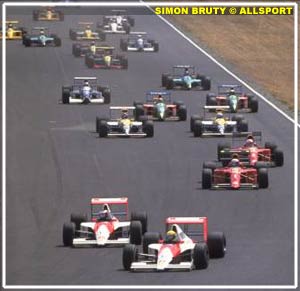 1990
1990
The field descends on the first corner at the Hockenheimring, lead by Ayrton Senna and his team mate Gerhard Berger in their McLaren MP4/5B Hondas. Immediately behind is the Ferrari 641 pairing of Alain Prost and Nigel Mansell, then the Williams FW13B Renault duo of Thierry Boutsen (left) and Riccardo Patrese. Holding down 7th at this stage is the Benetton B190 of Nelson Piquet with team mate Alessandro Nannini to the right. It is not unusual on the long straights of the Hockenheimring to see the cars race the early stage in team pairings.
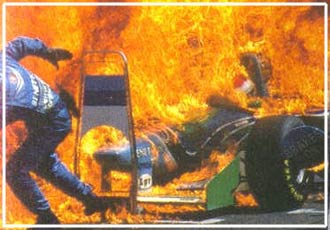 1994 1994 was a fairly ugly German Grand Prix. Michael Schumacher was racing under potential exclusion while the team explored legal avenues after the antics of Silverstone. Death threats by Schumacher fans had been issed against Damon Hill. The first corner saw two cars spins within the bunched field, Mika Hakkinen and Pierluigi Martini, and the spinners also took out of the race Frentzen, Herbert, Barrichello, Irvine, Blundell, Zanardi, Alboreto and de Cesaris. The Williams' of Hill and Coulthard were damaged and lost too much time in the pits. Finally a removed filter from the Benetton refuelling rig caused a spillage of fuel across Jos Verstappens Benetton B194 Cosworth. Verstappen was not badly hurt but suddenly the new refuelling laws were under the hammer.
1994 1994 was a fairly ugly German Grand Prix. Michael Schumacher was racing under potential exclusion while the team explored legal avenues after the antics of Silverstone. Death threats by Schumacher fans had been issed against Damon Hill. The first corner saw two cars spins within the bunched field, Mika Hakkinen and Pierluigi Martini, and the spinners also took out of the race Frentzen, Herbert, Barrichello, Irvine, Blundell, Zanardi, Alboreto and de Cesaris. The Williams' of Hill and Coulthard were damaged and lost too much time in the pits. Finally a removed filter from the Benetton refuelling rig caused a spillage of fuel across Jos Verstappens Benetton B194 Cosworth. Verstappen was not badly hurt but suddenly the new refuelling laws were under the hammer.
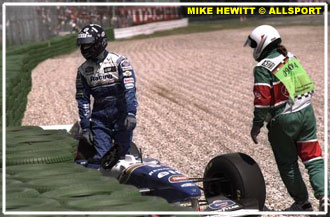 1995
1995
A marshall comes to the aid of Damon Hill as he alights from his sticken Williams FW17 Renault. Exitting the turn on the second lap the back of Hill's car stepped out beyond Hill's ability to catch it and hit the wall hard. It effectively handed the race to Michael Schumacher for an emotional home win on the way to his second championship.
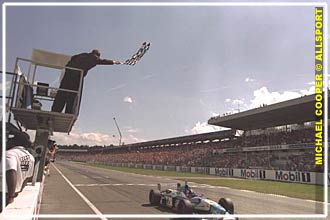 1997 Past the as always packed stadium section the evergreen Gerhard Berger on his way to his final victory of his long career. It was a final statement that Berger still had what it takes depsite a disappointing two seasons at Benetton where both he an team mate Jean Alesi had been pilled as championship threats in the car that Mike built. Here the Benetton B197 Renault was strong and fast and that was all Berger needed.
1997 Past the as always packed stadium section the evergreen Gerhard Berger on his way to his final victory of his long career. It was a final statement that Berger still had what it takes depsite a disappointing two seasons at Benetton where both he an team mate Jean Alesi had been pilled as championship threats in the car that Mike built. Here the Benetton B197 Renault was strong and fast and that was all Berger needed.
 1999 Pedro Diniz is completely sideways in the Sauber C19 Ferrari and being pushed by the luckless Jacques Villeneuve the the BAR 01 Supertec after the two became entangled in the early stages. It was another miserable 1999 day for the French-Canadian 1997 World Champion. Even as deep into the season as the German Grand Prix was Villeneuve had still to record a finish in the BAR, a car which seemed to absorb the dollars thrown at it like a sponge with little visible result.
1999 Pedro Diniz is completely sideways in the Sauber C19 Ferrari and being pushed by the luckless Jacques Villeneuve the the BAR 01 Supertec after the two became entangled in the early stages. It was another miserable 1999 day for the French-Canadian 1997 World Champion. Even as deep into the season as the German Grand Prix was Villeneuve had still to record a finish in the BAR, a car which seemed to absorb the dollars thrown at it like a sponge with little visible result.






















